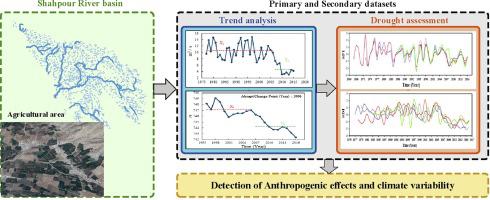Journal of Hydro-environment Research ( IF 2.4 ) Pub Date : 2021-01-19 , DOI: 10.1016/j.jher.2021.01.001 Mahmood Fooladi , Mohammad H. Golmohammadi , Hamid R. Safavi , Rasoul Mirghafari , Hassan Akbari

|
In recent years, climate changeability, hydrologic regime conditions, and human interventions have become crucial issues to be assessed. In this research, two annually recorded datasets were collected to analyse the change in the trend. The first set is comprised of precipitation, streamflow, and water quality variables including Total Dissolved Solids (TDS), pH, cation, and anion and the second one contains the mean groundwater level and agricultural water demand of four main stations of Shahpour River basin in the south of Iran. To recognize the fluctuating patterns, the Mann-Kendall Trend Test (MKTT), KPSS Stationary Test, and Pettit Homogeneity Test (PHT) of statistical methods were utilized at a 5% significance level. The Standardized Precipitation Index (SPI) and Streamflow Drought Index (SDI) were subsequently employed to detect the hydrological drought patterns. According to the statistical analysis, the streamflow and water quality depicted intensive varying trends, while there were slight decreasing trends for the precipitation series. Afterward, the abrupt changing points were identified in the first and second datasets between the years 2004 to 2007. The results of this study clarified that human activity effects (as a major factor) and climate variability (as a minor factor) have been affecting the Shahpour River basin. These effects disrupt the water chemical balance (the relationship between cations and anions) and hydrological regimes (increasing drought drivers) and consequently menace the health of the watershed.
中文翻译:

流域水文和水质变量趋势分析以检测人为影响和气候变化对流域尺度的影响:以伊朗为例
近年来,气候变化性,水文状况和人为干预已成为需要评估的关键问题。在这项研究中,收集了两个每年记录的数据集以分析趋势的变化。第一组包含降水,流量和水质变量,包括总溶解固体(TDS),pH,阳离子和阴离子,第二组包含Shahpour流域四个主要站点的平均地下水位和农业需水量。伊朗南部。为了识别波动模式,使用统计方法的Mann-Kendall趋势检验(MKTT),KPSS平稳检验和Pettit均质性检验(PHT),显着性水平为5%。随后采用标准降水指数(SPI)和水流干旱指数(SDI)来检测水文干旱模式。根据统计分析,水流和水质表现出强烈的变化趋势,而降水量系列则略有下降。之后,在2004年至2007年的第一和第二个数据集中确定了突变点。这项研究的结果表明,人类活动的影响(作为主要因素)和气候多变性(作为次要因素)已经影响了人类活动。沙堡河流域。这些影响破坏了水的化学平衡(阳离子和阴离子之间的关系)和水文状况(增加了干旱驱动因素),因此威胁到流域的健康。根据统计分析,水流和水质表现出强烈的变化趋势,而降水量系列则略有下降。之后,在2004年至2007年的第一和第二个数据集中确定了突变点。这项研究的结果表明,人类活动的影响(作为主要因素)和气候多变性(作为次要因素)已经影响了人类活动。沙堡河流域。这些影响破坏了水的化学平衡(阳离子和阴离子之间的关系)和水文状况(增加了干旱驱动因素),因此威胁到流域的健康。根据统计分析,水流和水质表现出强烈的变化趋势,而降水量系列则略有下降。之后,在2004年至2007年的第一和第二个数据集中确定了突变点。这项研究的结果表明,人类活动的影响(作为主要因素)和气候多变性(作为次要因素)已经影响了人类活动。沙堡河流域。这些影响破坏了水的化学平衡(阳离子和阴离子之间的关系)和水文状况(增加了干旱驱动因素),因此威胁到流域的健康。在2004年至2007年的第一和第二个数据集中确定了突变点。这项研究的结果表明,人类活动影响(作为主要因素)和气候变异性(作为次要因素)已经影响了沙普尔河。盆地。这些影响破坏了水的化学平衡(阳离子和阴离子之间的关系)和水文状况(增加了干旱驱动因素),因此威胁到流域的健康。在2004年至2007年的第一和第二个数据集中确定了突变点。这项研究的结果表明,人类活动影响(作为主要因素)和气候变异性(作为次要因素)已经影响了沙普尔河。盆地。这些影响破坏了水的化学平衡(阳离子和阴离子之间的关系)和水文状况(增加了干旱驱动因素),因此威胁着流域的健康。











































 京公网安备 11010802027423号
京公网安备 11010802027423号